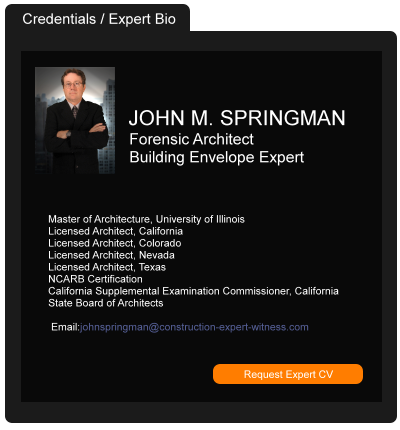BWB&O Expands to North San Diego
December 09, 2019 —
Bremer Whyte Brown & O’MearaBremer Whyte Brown & O’Meara is excited to announce our expansion to North San Diego County. Our new office location in Encinitas is strategically located between our Newport Beach and Downtown San Diego offices. The new North San Diego office will provide further resources to better serve our clients.
Read the court decisionRead the full story...Reprinted courtesy of
Bremer Whyte Brown & O’Meara
How to Protect a Construction-Related Invention
May 10, 2021 —
Patrick Barthet - Construction ExecutiveThey say necessity is mother of invention. That was surely true for Johan Vaaler, who in 1899 decided he was tired of having to sew pages together to keep them organized. Voila, enter the paper clip. This wasn’t the case for Percy Spencer. He was a radar tube designer working at Raytheon who, while working in front of an active radar set, noticed the candy bar in his pocket started to melt. Exploring the phenomenon further, he placed corn kernels in front of the radar and behold, he ended up with the world’s first microwaved popcorn. He patented the microwave oven in 1945.
Whether by necessity or by accident, what should contractors do if they develop a unique tool to accomplish some portion of their work faster, easier or less expensively? How do they protect it from misappropriation by competitors, or by an errant employee? We are all familiar with the fact that in today’s internet-driven market, it has become very easy to reverse engineer and knock off an innovative product.
The best way to safeguard an invention is, of course, to register it with the appropriate government agency:the United States Patent and Trademark Office (USPTO). Generally done with the assistance of a patent lawyer, the process is neither inexpensive or abbreviated. It could cost several thousand dollars and take 12 to 18 months. But, more importantly, this is not sufficient. Inventors must regularly monitor their patents to police possible infringers. Many folks think the USPTO does this, but it does not.
Reprinted courtesy of
Patrick Barthet, Construction Executive, a publication of Associated Builders and Contractors. All rights reserved.
Read the court decisionRead the full story...Reprinted courtesy of
Mr. Barthet may be contacted at
pbarthet@barthet.com
Recent Regulatory Activity
October 25, 2021 —
Anthony B. Cavender - Gravel2GavelSelected federal regulatory actions taken or proposed by several federal agencies, including the Environmental Protection Agency:
EPA Actions.
On September 15, 2021, EPA’s Water Office issued a memo rescinding a January 2021 guidance document that purported to provide the regulatory community with EPA’s understanding of the Supreme Court’s Clean Water Act ruling in the case of County of Maui v. Hawaii Wildlife Fund. That case involved a discharge of pollutants to groundwater which eventually made their way to the Pacific Ocean. Was an NPDES permit required to authorize this discharge, which was not initially made to a navigable body of water? The text of the Clean Water Act provided little guidance, and the matter has become very controversial. The Court held that if the discharge was the “functional equivalent” of a direct discharge, a permit may be required, and the Court described some factors that could influence a determination that there was the functional equivalent of a direct discharge. However, EPA has rescinded the January 2021 guidance, opining that EPA’s earlier analysis was inconsistent the Court’s opinion, and that the guidance was issued without proper deliberation within EPA or with its federal partners. Until new guidance is prepared, EPA will continue to apply “site-specific, science-based evaluations” to resolve these questions. On October 1, 2021, EPA released its “Climate Adaption Action Plan.” Briefly, EPA will take steps to ensure that its programs and policies consider current and future impacts of climate change and how the impacts disproportionately affect certain underserved or environmental justice communities. The agency’s air and water quality programs, contaminated sites activities and chemical safety and pollution prevention programs will be analyzed to determine their impact. Also on October 1, 2021, EPA released its draft FY 2022-2026 Strategic Plan to protect health and the environment. The plan, essentially an internal directive to all offices and regions, reflects a new “foundational principle”—to advance justice and equity by taking on the climate crisis and taking decisive action to advance civil rights and environmental justice.
Read the court decisionRead the full story...Reprinted courtesy of
Anthony B. Cavender, PillsburyMr. Cavender may be contacted at
anthony.cavender@pillsburylaw.com
Georgia Supreme Court Rules Construction Defects Can Constitute an Occurrence in CGL Policies
April 05, 2011 —
Beverley BevenFlorez CDJ STAFFRecently, the Supreme Court of Georgia reversed the decision in American Empire Surplus Lines Insurance Company v Hathaway Development Company, Inc. stating that because Whisnant’s faulty workmanship caused damage to the surrounding properties, the construction defects constituted “occurrences” under the Commercial General Liability (CGL) policy. Unlike the South Carolina Supreme court ruling in the case of Crossman Communities v Harleysville Mutual, the Georgia Supreme Court stated that an accident can happen intentionally if the effect is not the intended result.
�Interestingly, the only dissenting judge, J. Melton, disagreed with his colleagues on the basis that “although the term ‘accident’ is not specifically defined in the policy, it is axiomatic that an ‘accident’ cannot result from ‘intentional’ behavior.” It is clear that what constitutes an occurrence in CGL policies is still being hotly debated.
�Read the full story...
Read the court decisionRead the full story...Reprinted courtesy of
Don’t Miss the 2015 West Coast Casualty Construction Defect Seminar
April 01, 2015 —
Beverley BevenFlorez-CDJ STAFFThe 22nd West Coast Casualty (WCC) Construction Defect Seminar returning to the Disneyland Hotel in Anaheim, California is just six weeks away.
The annual event begins on Thursday, May 14th, with breakfast and registration starting at 7:30am. Panel discussions on various construction defect related topics begin at 8:30am and continue through the morning and afternoon, followed by a cocktail reception in the early evening. The following day includes break-out sessions with the event concluding in the afternoon.
Attendees can enhance their seminar experience with the WCC Construction Defect Seminar Mobile App. The event schedule, speaker information, product information, sponsor details, and interactive floorplan can all be accessed through the app. Furthermore, registered attendees will have access to session presentations.
The discounted, early registration ends April 15th, 2015.
Download an Invitation and Register for the Event...
Read the court decisionRead the full story...Reprinted courtesy of
Alert: AAA Construction Industry Rules Update
June 07, 2021 —
Christopher G. Hill - Construction Law MusingsThe American Arbitration Association has made some needed updates to their Construction Industry Arbitration and Mediation Rules, effective July 1, 2015. Among the changes listed at their website are:
- A mediation step for all cases with claims of $100,000 or more (subject to the ability of any party to opt out).
- Consolidation and joinder time frames and filing requirements to streamline these increasingly involved issues in construction arbitrations.
- New preliminary hearing rules to provide more structure and organization to get the arbitration process on the right track from the beginning.
- Information exchange measures to give arbitrators a greater degree of control to limit the exchange of information, including electronic documents.
- Availability of emergency measures of protection in contracts that have been entered into on or after July 1, 2015.
- Enforcement power of the arbitrator to issue orders to parties that refuse to comply with the Rules or the arbitrator’s orders.
- Permissibility of dispositive motions to dispose of all or part of a claim or to narrow the issue in a claim.
Read the court decisionRead the full story...Reprinted courtesy of
The Law Office of Christopher G. HillMr. Hill may be contacted at
chrisghill@constructionlawva.com
Florida District Court Finds That “Unrelated” Design Errors Sufficient to Trigger “Related Claims” Provision in Architects & Engineers Policy
March 02, 2020 —
Jason Taylor - Traub LiebermanMost professional liability polices include some form of a “related claims” provision that generally provides where two or more claims or wrongful acts are causally or logically related, they will be deemed to constitute a single claim. Importantly, these provisions typically provide that those “claims” are then deemed to have been “first made” at the time the first claim or act was committed for purposes of the policy’s claims-made and reporting requirements. Understandably, these provisions provide insurers and insureds with some clarity over the number and timing of claims that could involve multiple errors or omissions, and potentially aggregate all related claims or acts into a single policy period. While reasonable in principle, application of such provisions, especially involving large scale design and construction projects, is not always so easy.
Nova Southeastern University, Inc. v. Continental Cas. Co., 18-cv-61842 (S.D. Fla. Dec. 27, 2019), involved such an insurance coverage dispute with a design project gone wrong. DeRose Design Consultants, Inc. (“DeRose”) was hired as a structural engineer to design “ice tanks” to store and chill water for an energy efficient air conditioning facility constructed on the campus of Nova Southeastern University (“NSU”). An early water test on one of the tanks determined the walls of the ice tank deflected, leaked, and cracked when the tank was filled with water. DeRose later discovered that the problems with the ice tank were caused by a structural design error.
The first errors were discovered in early 2009, and reported under DeRose’s professional liability policy with Evanston. DeRose then created a remedial design to repair the tanks, which involved strengthening repairs. Additional leaking and an early indication of corrosion involving the Remedial Design arose as early as October 25, 2009. Several field investigation reports were prepared in 2011 and 2012 confirming these issues with the Remedial Design. A third report in February 2012, however, identified a new error involving the concrete slab under the ice tanks also designed by DeRose. The third report concluded that the concreate slab was overstressed and could not handle the loads of the ice tanks. The report also concluded, however, that the design defects in the concrete slab were “unrelated” to the original design defect of the ice tank walls or Remedial Design.
Read the court decisionRead the full story...Reprinted courtesy of
Jason Taylor, Traub LiebermanMr. Taylor may be contacted at
jtaylor@tlsslaw.com
Wall Street Journal Analyzes the Housing Market Direction
June 26, 2014 —
Beverley BevenFlorez-CDJ STAFFNick Timiraos of the Wall Street Journal listed “five takeaways” from this week’s housing reports. First, he stated that unless the May “seasonally adjusted annual rate isn’t revised down,” the sales of new homes were “at their highest levels in six years.”
Second, Timiraos claimed that “[s]ales have been soft, in part, because builders have been slow to ramp up production. While inventories are still very low, they are up 16% from last year.” For his final “takeaway,” Timiraos stated that while “home prices are up nearly 25% from their early 2012 levels, they’re still down 18% from their 2006 peak. There’s considerable variation, of course, from one city to another. Prices in Denver and Dallas have reached new highs. Others, such as Miami and Phoenix, have posted double digit increases over the past year, but prices are still off of their peak by more than a third.”
Read the court decisionRead the full story...Reprinted courtesy of


































































